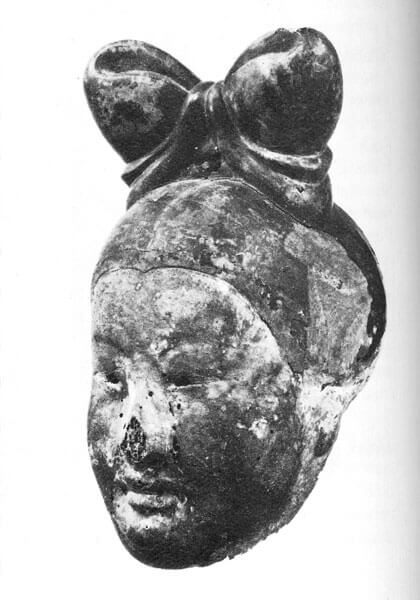Gigaku, Buddhist Mask Theatre
- The frightening, yet benevolent King of the Wu Kingdom, a wooden gigaku mask National Museum, Tokyo
Gigaku was a form of Buddhist processional dance drama, which reached Japan in the 7th century from Central Asia through Korea and China. Gigaku blended religious themes with comedy, and even burlesque scenes, while the performances took place in temple courtyards. Its performance tradition died out in the Heian period (794–1192). Wooden gigaku masks are now valued as high-quality artefacts, preserved in temple treasuries and museums.
The History
It is assumed that gigaku originated in India, from where Buddhism spread to Central Asia and from there, via the so-called Northern Silk Road, further to China, Korea and Japan. The Silk Road was a network of caravan routes, which for thousands of years connected the Mediterranean world with India, Central Asia and East Asia.
Before the Muslim invasions in Central Asia there flourished numerous prosperous Buddhist centres, with which China, Korea and Japan had close contacts. Central Asian Buddhism and arts deeply influenced the culture of East Asia.
Among the cultural expressions adopted from Central Asia was also a tradition of Buddhist mask processions, known in Japan as gigaku. In fact, most of the evidence of the tradition, in the form of wooden masks, can now be found in Japan. Due to the Japanese tradition of carefully preserving religious artefacts in monastery treasuries, there still exist as many as some 250 masks.
Besides the masks, there also exists textual evidence that throws light on gigaku’s history. According to this evidence, it was in the 7th century that gigaku was brought from Korea to Japan, although gigaku masks and costumes had already been known there. It is believed that gigaku was performed in Japan for the first time by a Korean actor in 612.
The dancer was invited to teach the art of gigaku to Japanese boys. Thus this tradition, which was widely practised in the Buddhist world, was also adapted to the Japanese context. It replaced earlier Buddhist types of performance and it flourished particularly in the 8th and the 9th centuries. Its popularity gradually diminished in the 10th to 12th centuries and soon the tradition completely died out.
The Mask System
Gigaku masks are classified as follows:
- Kojin, foreigners or “barbarians”
This group includes masks representing members of various nations from the Silk Road regions, such as the Drunken Persian King. - Gojin, people of the Wu kingdom
- The beautiful Princess of Wu National Museum, Tokyo
This group includes the King and the Princess of Wu as well as Buddhist guardian spirits and several ordinary citizens, such as a wrestler, an old couple with children etc.
- Nankaijin, native of the Southern Sea
The main character in this group is the Konron, or the demonic arch-villain, who represents greed and other “low” human qualities. - Irui, various animal characters
This group includes a lion, a protector of Buddhist doctrine and a bird related to the mythical bird of Hinduism, Garuda.
The Performance
According to textual sources the performance took place in a temple courtyard at which the masked actors and their accompanying musicians arrived in a solemn procession. The orchestra included two flautists, two cymbalists and twenty drummers.
The procession proceeded for a couple of times around the temple building and was led by a lion and its attendants, two dancers wearing children’s masks. They performed a dance in order to venerate the five cardinal points of the universe. Variants of the Lion Dance are still known in many parts of Asia today.
After the procession, the actual play, called Konron, began with the entrance of the King of Wu, after which a mythical bird performed its dance. The beautiful Princess of Wu was then introduced. She inspired the lustful demon Konron to perform his wild dance with a phallic staff in his hand. The demon kidnapped the princess. However, Kongo, the frightening, yet benevolent, guardian of the Buddhist doctrine arrived and was able to bin the phallic staff with ropes.
Three mime scenes followed the main play. The first one showed a poor, fallen monk, who is washing his baby son’s clothes. The second mime scene described a poor grandfather, who with his orphaned grandchildren is making offerings in a temple. The third scene elaborated the stock character of a Drunken Persian King. The whole programme ended with a joyous procession.

